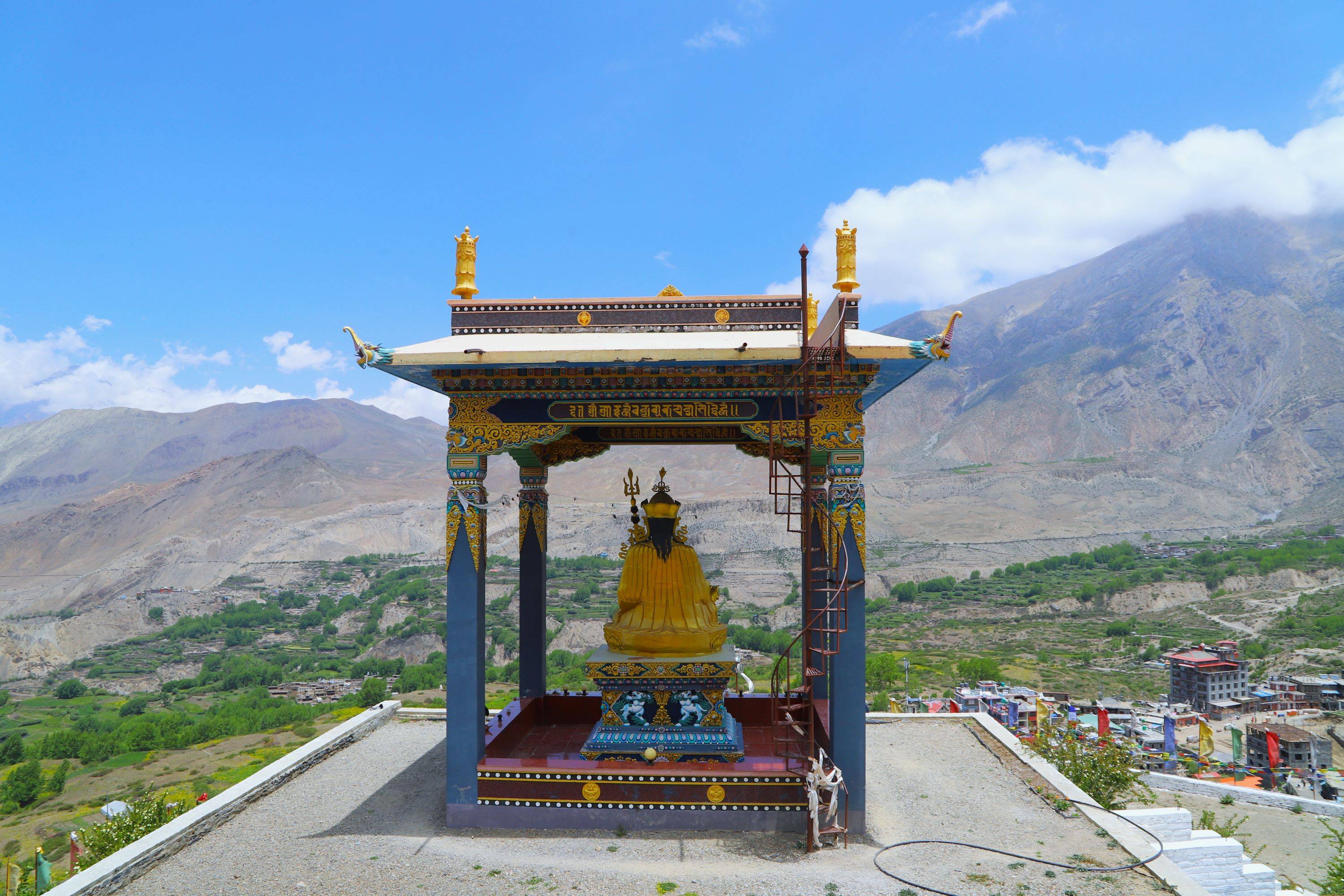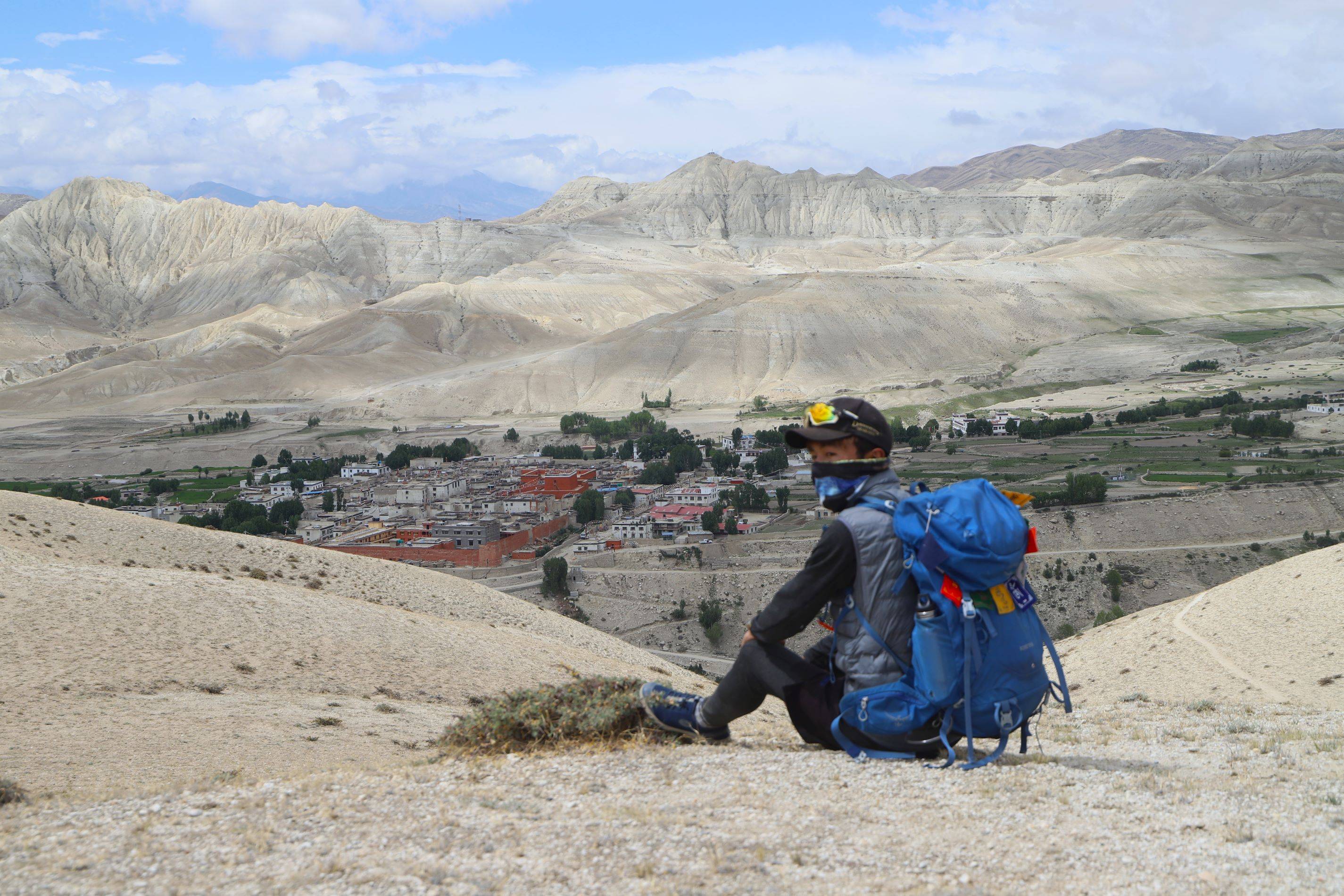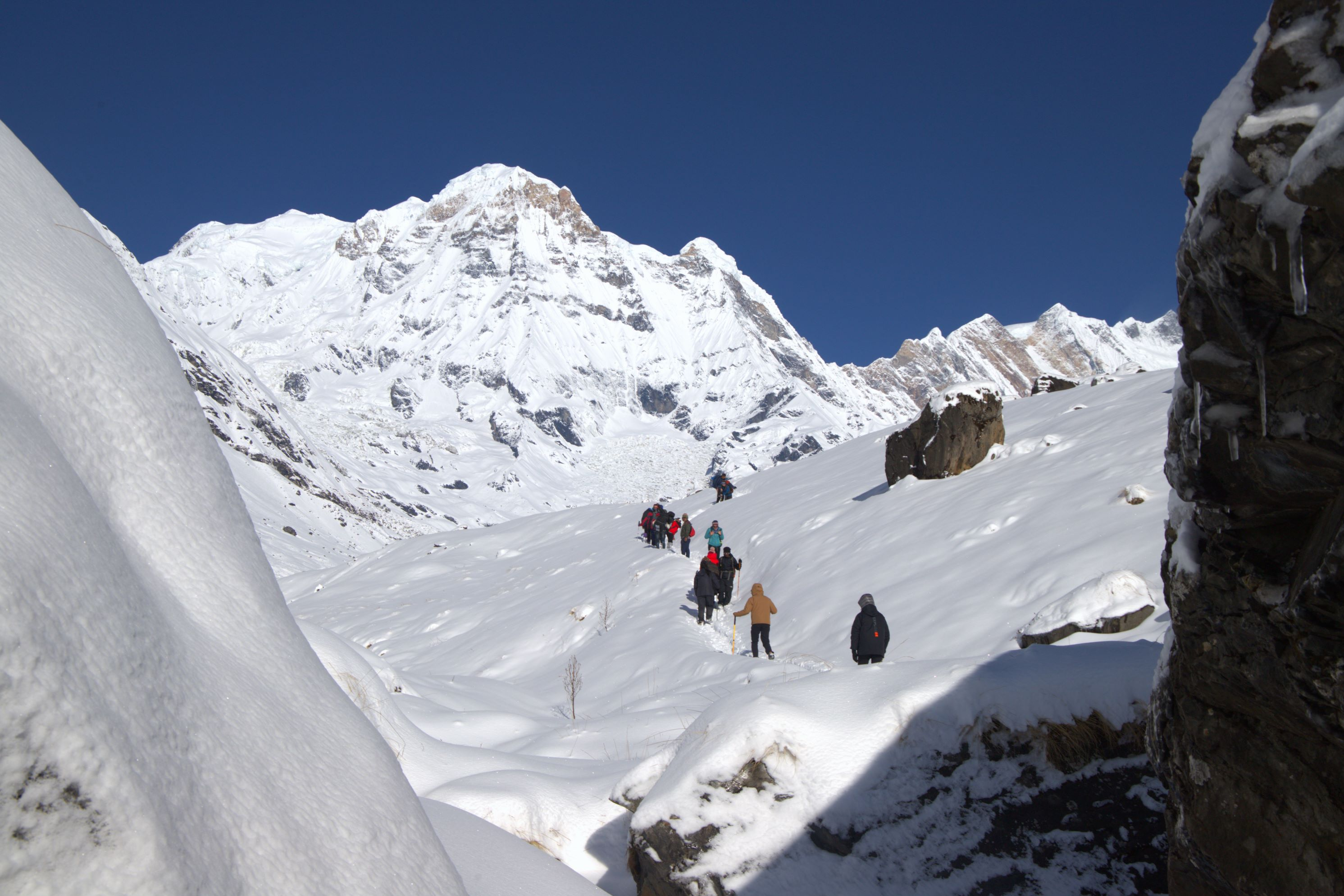Initiating our tour, we leave Kathmandu and drive towards west until Zero kilo, the starting point of our trek. We drive via Abukhaireni along the Trishuli River on our right throughout our drive. We follow upstream to its junction with the Marshyangdi River then we gently ascend through heavily terraced fields. Upon reaching to Abukhaireni, we now drive north and then follow the waggling road up to Zero Kilo. After taking our lunch, we commence our trek to Simalghari. Simalghari is a small village which is located at the bank of Daraundi River. This village is residence for Gurung, Ghale, Tamang, Bhatta, Miya, Pariyar, Bishwokarma, etc. Most of the settlement includes Gurung and Ghale. They speak their own languages. The most common language used by the local residence is Nepali, Ghale and Gurung. Only few people knows English, especially students. The Daraundi suspended bridge is 180 meter long. You walk along a flat trail today. En route you can feel the fresh air and surrounding. Upon arrival at Simalghari, you can visit the government school and old market of the area. Overnight stay at lodge in Simalghari.



After breakfast, we commence our trek through the complanate trail crossing the suspension bridge over Daraundi River. The walk is easy and you will get an opportunity to endorse the magnificent views of Mountains, forest, villages while passing by. You will cross through a terrace fields and in some point you will be amazed by the views of snow peaked mountains which are at some distance. Upon arrival at Palungtaar, you will explore around the village. Palungtaar is a pretty big village inhabited by Brahmins, Chhetri and Newar. You can observe the terraces, mango gardens and oranges in some places. Overnight stay at lodge in Palungtaar.



On the following day, we begin our trek after having breakfast in Palungtaar. Today also you will walk through the complanate trail. Crossing the stream and passing by few villages we continue our journey. We will enjoy fresh brewed Nepali tea and oranges (orange farming in this area is quite popular, every house having at least over 20 trees). Enroute you come across a few grazing fields where local people bring their domestic animals. Upon arrival in Tarkughat, you will be welcomed by the group of local peoples with a smiling face and warm greetings.
Tarkughat is a village development committee in Lamjung District in the Gandaki Zone of northern-central Nepal. Newar, Chhetri and Brahmins are the local resident. This village lies at the bank of Marshyangdi River. You can enjoy swimming in the Marshyangdi River. This place is full of beautiful terraced farm land where whole hillsides bloom yellow from the flowering mustard plants during the months October to February make for a memorable sight. Overnight stay at Tarkughat.



To reach Kunchha, we ascend uphill until we reach Sundar Bazaar. Sundar bazaar is an old market in Lamjung District. It has recently been a Municipality by merging different Village Development Committees like: Bhoteodar, Sundar Bazaar, Parewa Danda, Tarku and Kunchha. You can see these villages at some distance from Sundar Bazaar. Moving ahead through terraces, you will get an opportunity to enjoy the views of splendid snow peaks. After some hours of walk time, you will arrive at Tuhure Pasal where you will find few typical tea shops. Further walking gently uphill, you will reach Kunchha. Kunchha is a popular village of this area and you will have and excellent views of snow capped Mountains from here like: Manaslu, Lamjung and Annapurna. This place is also best known for the sun set view. People living in harmony here belong to different communities and are farmers, government employees and a few have joined the army. Overnight at lodge in Kunchha.



Today, we descend downwards passing through terraces growing millet and maize over the 35 kilometers that takes us further east and after just 4km of flat and a small climb we reach to Urchale Bhanjyang (Bhanjyang meaning small pass). Now we have to descend further 12 kilometer downhill to Karputar and then we cross the Midim River and reach Bhorletar. It’s a small town with just a few shops to serve the local settlements. We will take a break here and grab a snack from these local shops, giving a few insights to local culture and their way of life. After lunch, we walk again in an easy trail to Sisaghat. Sisaghat is another human settlement of this area. The main inhabitants belong to a mixed community and it lies at the bank of Madi River. Along the way, each and every place we visit on this route offers variations on food, culture and traditions. The road we travel used to be an old trekking route from Kathmandu to Pokhara via Gorkha, before there was any road network connected. Overnight at lodge.



Leaving Sisaghat, we walk along the bank of Madi River passing through terraces once again. Today we have to walk for about six hours in order to reach Karputaar. We have to gentle ascending trail today. En route we come across several villages rich in their distinct culture. Karputaar is a small village with mixed community. Overnight at lodge.



Among all the trekking routes, you will find this route a bit effortful as you have to walk gradually uphill in the beginning and later have to climb some steep hills. En route you cross through forests covered with local vegetation and cross a few streams. At some distance, we can also see snow peaks. After an ascend for about six hours, we reach Syaklung.
Syaklung is a village dominated by Gurung, Magar and other communities of Nepal. There is an excellent camping spot here. Moreover, you will find recently opened tea shops and small lodges. This place grants you an opportunity to enjoy the views of Annapurna South, Fish tail, Annapurna II, Lamjung, Mardi peak, Manaslu and several unnamed peaks. Overnight at lodge.



Today we have to walk 200 meters in order to reach Kalikasthan. At first, we trek downhill and then follow an ascending and descending path. The trail follows along the forested ridge top through rough drivable road, passing through Thulokot and Majhthana (1220m.). You are accompanied by views of Machhapuchhre, the Annapurna range, Lamjung Himal and Manasalu. Kalikasthan is a village inhabited by Hindu people and named after goddess Kali as there is a temple with an idol of Kali at the top of the ridge. There is also a well managed camping spot. Here, you will find small local shops with minimal supplies, typical tea shops and very small lodges. One cannot miss observing the sunset as this will be the memorable experience of this trek. Overnight at lodge.



On the following day, we pass through local villages of mixed ethnic groups and rice growing terraces up to Mardi Khola. Descending down to the river valley, we follow the easy trail along the riverbank passing through waterfalls. After walking about 5 to 6 hours through villages of mixed ethnic groups, rice terraces and jungles we reach Lama Chaur. Lama Chaur is a small village dominated by Gurung settlement. This place is surrounded by lush green hills that stretch for miles which stirs the imagination for good thoughts. We camp for our overnight Lama Chaur.



Today, we start our trek after having breakfast through dense rhododendron forest. The trail stretches at flat level along the river bank until we reach Khilan Gaon. After this, we follow path which is gently up at some distance and steeply up for some hours. En route we pass Parju village. The trail again climbs till Siklish village.
Siklish is the Nepal’s second largest Gurung village. It is one of the oldest and big Gurung villages. Most of the people serve in Indian and British Army. You can have an excursion around this Gurung village of Siklish. The major attraction of this village is traditional Gurung lifestyle, handicraft production, local cloth weaving tradition and the ancient water driven flourmills. The flower forest of rhododendron is also one of the highlight of this region. This is the best point at which to see the panorama of the Himalayas and close views of Lamjung Himal, Annapurna II and Manaslu. Stay overnight at camp.



On the following day, we head forward towards Ghale Gaon. We trek through forests covered with rhododendron. Ghalegaon is a small village which is mainly inhabited by the Gurung and Magar communities and was named as second village tourism destination after Sirubari of Syanja. The Gurung’s, dwellers of Annapurna and Manaslu Himal regions are famous for hard working and their bravery. The guests are treated here with proper hospitality and are served with clean and delicious organic food. Here in all the villages, well furnished rooms and clean toilets are available. This place is also famous as it lies along the route of Annapurna Region. From the villages, we can also observe the panoramic view of many Himalayas, such as Buddha Himal, Himalchuli, and Manaslu in the East, Lamjung Himal and Annapurna on the North and the peak of Machhapuchhre on the west. The area has green pastures of grasslands and rich in fauna including medicinal herbs, rhododendron forest. We spend overnight here.



Commencing trek from Ghale Gaon, we will walk for about half an hour in order to reach Ghanpokhara. Ghanpokhara is a model village for experiencing the typical culture and lifestyles of the Gurung people. Traditional customs are still followed during births, deaths, marriages and in other rituals. Age old cultural dances like Jyaure, serka, dohori, Ghatu, Sorathi, Jankri etc are performed on various occasions accompanied by different musical instruments and with the dancers in traditional dress. Further walking up to about two hours, we reach Bhujung.
Bhujung is a really interesting and beautiful village with the largest settlement of Gurung people in Lamjung district. This traditional Gurung village is situated high on the mountain at an altitude of 1600 meter. The village is a closely packed cluster of around four hundred houses. This village has emerged as an attractive destination among tourists to observe the traditional Gurung life-style and culture. The main attraction of Bhujung is the same “Bhujung” tribe in the entire village. Houses are crowded in both sides of a small footpath. The green valley with rice fields is wonderful just down of Bhujung which is very popular for honey hunting. There are a number of honey hunting sites with lots of hives.
After exploring the beautiful Bhujung village and taking some rest over there, we descend back to Ghanpokhara. It is a steep descend for half and hour. Since there is shortage of drinking water so be sure that you carry enough drinking water by yourself. Overnight stay at lodge.



After having such a memorable journey of Ghale gaun trek, we trek back through the same route to Khudi. Our trail descends through the small village and forest to the river side. One your way back, you will cherish back all the memories and excitement that you had while trekking to Ghalegaon. We continue our walk along the bank of the river till Khudi where we stop for overnight.



Leaving the Khudi bazar we drive to pokhara or Kathmandu as per your itinerery by there Private car.









Discover incredible offers for your upcoming adventure by subscribing to our newsletter with the latest travel tips and updates.
